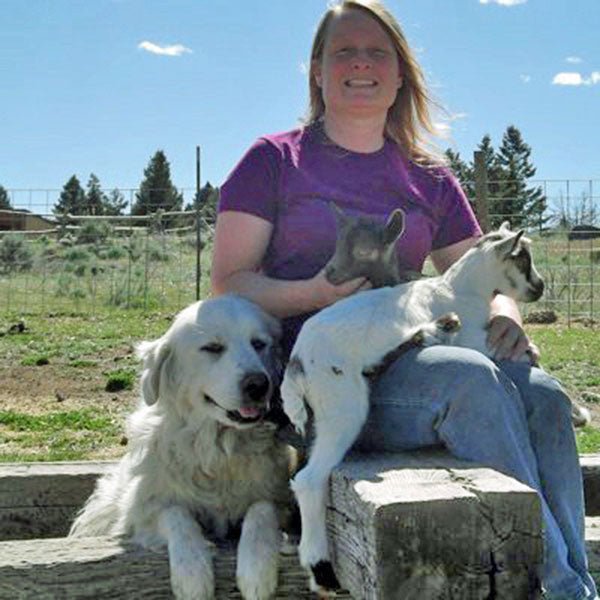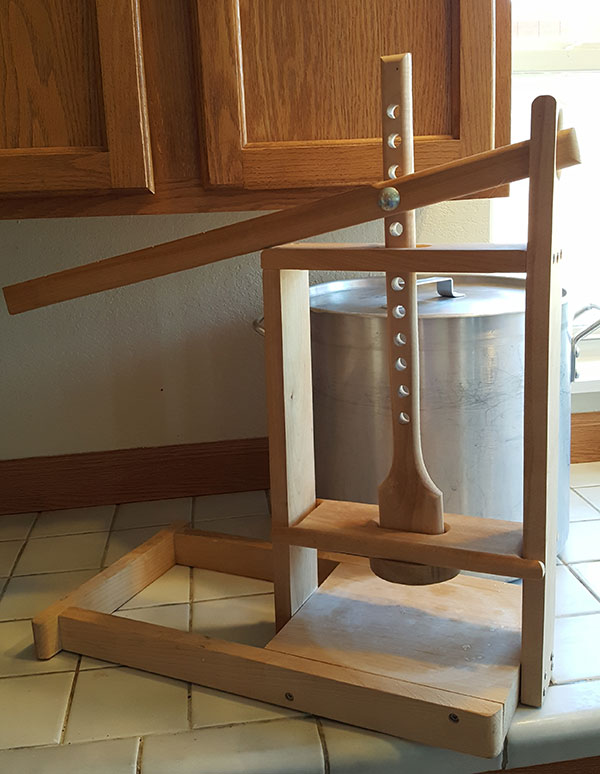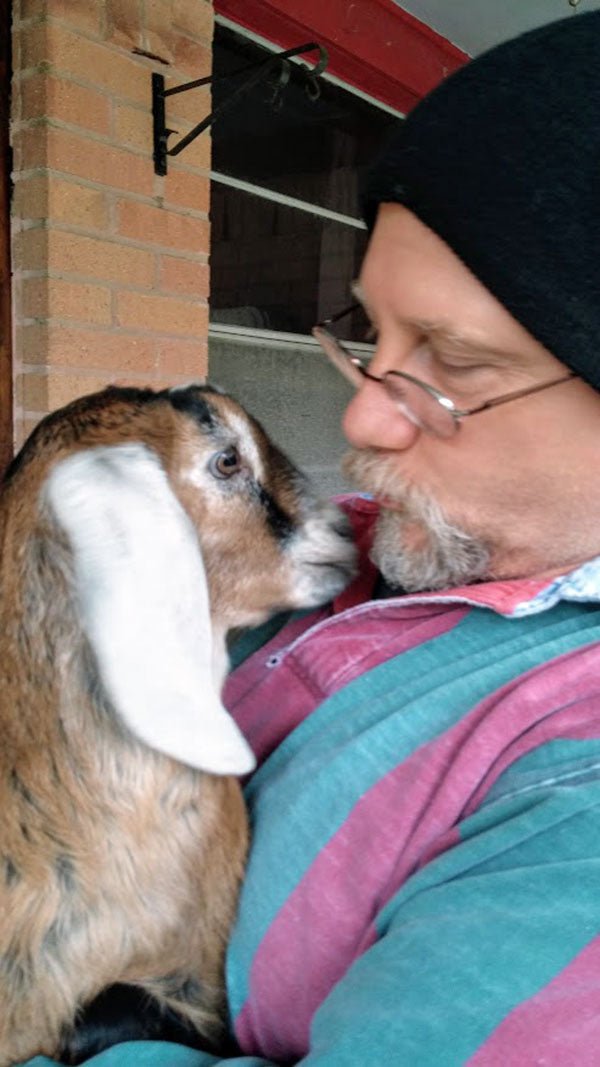
Wendy Gardner is a master home cheese maker who raises and sells Alpine dairy goats in southwestern Montana. She does this on top of the Continental Divide at an altitude of 6000 feet. Her herd averages 70 goats at any one time, so, she has a LOT of milk to make cheese.

Wendy’s house with view of Highland mountains, part of the Rocky Mountains and also the Continental Divide.

She can see four mountain ranges from her place.
It seems difficult enough to raise goats at such a high altitude, but her biggest problem surprised us:
I love the wildness of Montana and the mountain views. But the wildlife can be exhausting. We have had every predator up here – coyotes, wolves, eagles, bears, and a mountain lion. I’m trying to reduce the herd as we have been spending a fortune on hay. The mule deer munch on it all winter. Last year we had over 35 regulars eating twice a day and then this spring we also had a herd of bull elk. They cleaned us out.
Wild elk?!!
Yes, wild elk. The jerks. They are huge, bigger than my horses. We get all sorts of wild animals. Last night the coyotes were here. The week before we had two wolves. My Great Pyrenees are worth their weight in gold. Luckily, we haven’t lost a single goat.
It’s beautiful but hard to get a good night’s sleep!

Interview
How do you sell goats from such a remote location?
I sell breeding stock. I have sold breeding stock for almost 30 years now. I love my girls and I find genetics fascinating.

Eidelweiss
I’ve started some commercial herds in the central valley of California and helped a lot of first time goat owners. It’s not unusual for me to spend over 2 hrs with a first time owner, trying to impart 30 years of experience. Boy, I think I wear them out with too much information! Anyone who has bought from me knows they can always call with any questions.


Kahlua out of Xpresso. We call her Knievel. For all her daredevil stunts. Evel Knievel was a Butte resident. Butte, MT is our closest city.
We ship all over the US (including Alaska) and have been asked to ship internationally. But haven’t yet.
I haven’t shown for some time as we are too far away from the ADGA shows and you need to show in more than one show a year to champion a goat. Also I don’t have a person to milk/house sit while I show.


Cheese
At her website Wendy has an impressive list of the cheeses she makes with descriptions of each one. They include Valencay, Brie, Gouda, Alpine Tomme, French Tomme, Wasabi Tomme, Crushed Red Pepper Tomme and Cheddar. She also shares her philosophy:
All my cheese is made, as much as possible, with classic European processes. I use the same type of goats that would be used to make these cheeses in France. I use the process that has been traditionally used to create the soft cheeses. I do not cut the curd or apply other process that will extend the shelf life on them, so when they are ripe they have a shorter window of opportunity to be perfectly aged. But I feel the flavor complexity is worth the extra effort.

Valencay

How did you start making cheese?
I moved from California to Montana with the idea of starting a cheese business. I wanted to spend all day with my girls (does) and I needed something to do with the gallons of milk I have every day. I still am looking for capital to start the facility. I would love to run goat 101 workshops and cheese classes. But right now I just make a lot of cheese for home use.

Brie with wildflower.
How do you find the time to make cheese?
I am a Realtor as it allows me to have a flexible schedule for herd chores, milking, hoof trimming, kid training, and cheese making.
How often do you make it?
I’m making cheese every other day, right now. And, still, I’m dumping gallons of milk. I’m milking 10 does and getting over 20 gallons a day.

Gouda
You really have to dump milk?
Yes, I do dump it out. These girls produce so much milk I just can’t use it all.

Peppercorn white cheddar with a rubbed paprika rind
What kind of cheese do you make most?
I have to see how much time I have to make the cheese. Soft cheeses are great if you have to do something quick as you can mould them the next day. I’ve also found if I start making right after milking, I don’t have to heat the milk. When you bring it out of the fridge, you have to heat the milk to the temperature you need. By using it while its still warm, I save all sorts of time. We eat a lot of soft cheese for picnics and when we go hiking or have guests over.
The hard cheese I love to make until I run out of cave room. As they get older, I can squeeze more cheese wheels into the cave on their sides. I have an 8 gallon pot, so most of the wheels are about 8 pounds. You should be getting about a pound per gallon, roughly.

What are you doing with all your cheese?
We eat the cheese. I posted it on my website because I wanted people to realize that you can make numerous cheeses from goat’s milk. I took a year off work and moved the herd (and our horse, cats and dogs) to Austin, Texas. I made cheese every day and was able to sell it to friends. Montana law doesn’t allow for unpasteurized sales, so, I don’t sell any in Montana.

Crushed red pepper tomme
Did you go to France to learn?
No, I wish I’d gone to France. I have dabbled in cheese for quite a while but about 5 years ago I took a year off from work and just made cheese. Every day. So, we moved the herd, the 6 horses 2 dogs and 2 unhappy cats to Austin Texas, for a year.
Anyway, I tried to make a lot of cheese. I’d try and make the same recipe over and over, so say, 2 weeks of Goudas. That way I’d really get the nuances of the recipes down or hoped to!
I also read just about every cheese book out there. Or try to. Loved Max McCalman’s, Mastering Cheese. It really lets you know what’s out there. The Fabrication of Farmstead Goat Cheese by Jean-Claude Le Jaouen was also a good read. (You guys published it, Yeah!)
But, for the actual chemistry explanations and cheese recipes (the simple stuff), I read Artisan Cheese Making at Home by Mary Karlin and Mastering Artisan Cheesemaking by Gianaclis Caldwell. Both were really helpful books.

Cheddar
What are your goals?
I’d like to find a good recipe for Chabichou du Poitou which is my favorite soft cheese.
I also hope to one day build a cheese production and tasting room. Hopefully up here in the mountains. I guess it would be a destination cheesery.
I’m also trying to spread the word that you can make much more than chevre with goat’s milk. I think you can make just about any cheese with it and it should not taste gamey! I have a four year old grating cheese. I guess it would be like a parmesan – it’s delicious and rock hard. When I started making cheese, I was told you could only make soft cheeses. That is not so.

Alpine tomme
Do you have any advice for beginners?
Read all you can. So you get the basic idea of cheese making and the chemistry involved.
Then, don’t be afraid to put your own twist on things. Make it your cheese.
And, the most important part. Eat lots of really great new cheeses!















































































































































